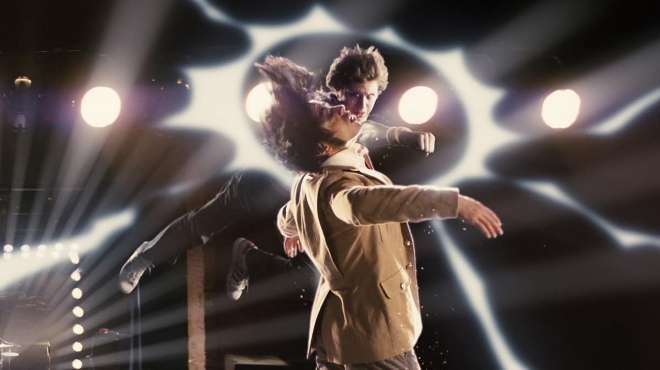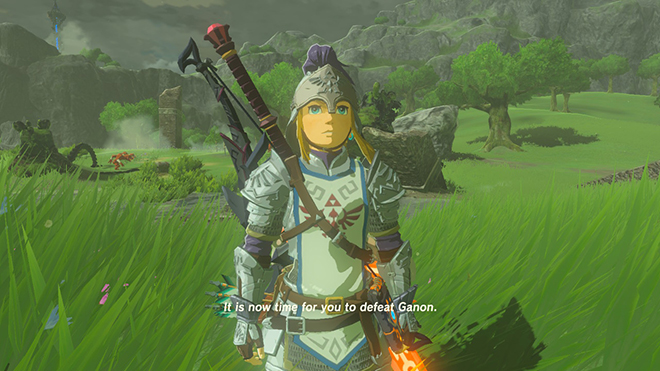Quarantine Control #201: Marvelous Pilgrims vs. The Wilds

The Quarantine Control series here reached an important milestone with the 200th entry last week, in which a couple of us discussed the horrible state of the world during the COVID-19 pandemic’s worst moments. Now that the pandemic is largely behind us (though, again, whether it should be is an entirely separate question), we might have emerged even worse from it. That goes double for the United States, where there’s a significant plurality of voters who believe turning the country into an autocracy would be a great decision. Not to say that the current leadership has done the best job, especially regarding protecting Gaza, but things could get worse before they get better.
It would be nice if this entry could start off more positively, but let’s perhaps save that for the stuff we watched and played.
Geoffrey Barnes
Scott Pilgrim vs. The World (2010)
Source: Amazon Prime Video (which has ads now — yuck)
Episodes: 1 movie

No, you’re not seeing things here: I’m really talking about Scott Pilgrim vs. The World this week. Allow me to blow your mind by saying that, yes, I watched this movie for the first time, about 14 years after it originally released in theaters. I had plenty of opportunities to watch it through the home video releases and how it bounced from one movie channel and streaming service to another, but I just never got around to it. Unforgivable. But it’s better to rectify those sins late than to never come to grips with them. Now that the Scott Pilgrim Takes Off anime has come and gone to a largely superlative reception, I finally watched the movie that made several fans of the franchise. The movie was also right up my alley, something I also shouldn’t be surprised about.
I vividly remember the promotional trailers and ads for the film, and how misleading they ultimately were. Anyone who watched them without reading a synopsis could have easily thought this film was a coming-of-age story for a series of college students, though this was bound to not be the case considering how faithful of an adaptation this was of the comic. (There are still coming-of-age moments in the story, however.) It’s probably why the movie failed in the box office. But even during its earliest points, it’s stuffed full of nerd references. From the appearance of a Nintendo DS Lite (this was released in 2010) playing The Legend of Zelda: Link’s Awakening DX to the overabundance of references that would fill up an entire post.
That’s all before the real story shows up, which begins when Scott Pilgrim (Michael Cera) somewhat breaks things off with his underage then-girlfriend Knives Chau (Ellen Wong — who was not underage during the time of filming) for a fling with Ramona Flowers (Mary Elizabeth Winstead). Pilgrim doesn’t realize at the time that she has a bunch of vindictive ex-lovers that he’ll have to fight. Ramona just has that kind of effect on people, the reason why Scott is attracted to her in the first place. The battles and fights themselves are entertaining while being full of shout-outs, some of which might even fly over the heads of most people who proudly call themselves nerds. But it’s always good and entertaining.
I’m actually putting that lightly: Scott Pilgrim vs. The World has a concept that absolutely should not work in live-action form, from the character appearances to the fights themselves. But the movie shines because it all works splendidly. Director Edgar Wright and the writing team knew how to split the difference and implement what would work in live-action despite the ridiculousness of it all, and minimized what wouldn’t. The special effects for the elaborate fights between Scott and the bosses are over the top, but are written well enough for the viewer to still take them seriously.
It’s also nice that the references to nerd works like Super Mario Bros., Street Fighter, and even the old Ninja Gaiden games are very prominent, but aren’t overt enough to distract from the story the series wishes to tell and the character development. This is what Ready Player One should have learned from, even though that movie adaptation wasn’t bad per se.
I didn’t have many problems with the film at all, but I do wish that characters like Envy Adams and Lucas Lee had slightly larger roles, especially in the former’s case. But that’s not the movie’s fault. It’s just that they utilize actors and actresses who’ve become far more popular in the time since this movie originally released. Envy and Lucas were played by Brie Larson and Chris Evans, respectively, both of whom have (or have had) parts in the Marvel Cinematic Universe. Their screentime did make sense in 2010, of course, parts in a movie that has one of the best retroactive all-star casts around. It’s nice that none of the actors felt they were too above Scott Pilgrim at this point when they reprised their roles in the anime.
Yeah, I really should not have taken this long to watch Scott Pilgrim vs. The World, so I’m not telling anyone anything new by saying that it’s a delight. But… Scott Pilgrim is a real delight. Sorry. I’ll make sure not to take as long to get around to Scott Pilgrim Takes Off, I promise. Maybe that will only take seven years.
Angela Moseley
The Legend of Zelda: Breath of the Wild (2017)
Source: Nintendo Switch
Episodes: 1 Video Game

As promised in previous Quarantine Control entries, I finally beat The Legend of Zelda: Breath of the Wild as my first Four in February game. I’ve been playing on and off since early July. I had the most time to play during long bouts of time off from work, and this session was no different. In the middle of a week-long vacation, I sat down yesterday afternoon to finally finish. I knew I was near the end, but I had no idea it would take me eight hours to finally see the credits roll early this morning.
When I last wrote about the game for QC #187 I was avoiding Death Mountain and mopping up side quests around the Tabantha Frontier. I was satisfied having finally cleared out all the Lomei Labyrinths. It was finally time to face the last Divine Beast. I created several fire resistance potions and made the toasty trek to Goron City. I fought various enemies along the way, including a Magma Talos, but it didn’t take me long to beat it into submission.
Once in the city, I found fire-proof armor quickly. Navigating the area was a pain since the armor had lower defense than my preferred armor. Also, as with every Zelda game falling into lava is quite dangerous. Once I found the quest line to take on Divine Beast Rudania, it wasn’t long before I found myself taking back control of the mechanized creature. Getting to it was an involved process, but it was the easiest of the four beasts to reach. The gimmick for manipulating the dungeon inside was also easy to figure out. With all the Divine Beasts restored to the control of their rightful owners, I had several choices to make.
With aid from the four champions and the Master Sword in tow, I could go straight for Hyrule Castle and challenge Calmity Ganon. Ultimately, I decided to find all 120 shrines since I had discovered more than half of them. I also decided it was also a good time to find the rest of Zelda’s memories. I tried my hand at some of the more intriguing side quests as I searched for memories. Seeing Tarrey Town built was an adventure in local deforestation. I also managed to find the three Great Fountain Fairies after acquiring a lot or rupees.
At some point, I ran out of patience for the regular side quests. It was between getting my ass kicked by Savage Lynels in order to snap a picture of large fossil, and some kid wanting to see various weapons dropped by monsters. With the Great Fountain Fairies restored, I decided to upgrade as much as my armor as possible. That meant once again going toe to toe with more Lynels in order to obtain their parts. The upside is that I got better at fighting them once I found additional shrines to improve my health and upgraded my armor at the Fairy Fountains.
I’d rate finding Zelda’s memories slightly more frustrating than finding all 120 shrines in the base game. Only because shrines give you the ability to improve your health and /or stamina. The memories are there to flesh out the story and give you the game’s true ending. Finding them involves looking at a picture and finding the same area in Hyrule. If you don’t really care about the story, taking the effort to find all the endings may not be worth the effort. I found the experience to be rewarding especially when combined with reading various journals scattered throughout Hyrule.
When the credits rolled, I was satisfied with all I accomplished in the game, doubly true given how everything after upgrading the Sheikah Slate is optional. I freed all four Divine Beasts, found all 120 shrines, located all the memories, obtained the Master Sword, and acquired Link’s Breath of the Wild tunic and the original armor from the NES games. Even so, there’s still so much to do. I could have hunted down all 900 Korok seeds, filled out the bestiary, and completed all the side quests before even mentioning the DLC campaign. Breath of the Wild is a game that can take tens of hours to complete or hundreds of hours, depending on how much you want to see.
My biggest gripe remains the weapons durability feature. Even though you’re provided ample weapons throughout the game, having them break on you isn’t fun. I was never interested in seeing all the weapons available and just grabbed whatever enemies dropped. Those weapons ranged from mediocre to amazing. I honestly thought having the Master Sword would cure my weapons durability woes, but again even its use was extremely limited when compared to other Zelda games. The only upside of constantly breaking weapons is slowly getting stronger as you improve your skills, gain better armor, and acquire more money to purchase equipment. (Yes, using Amiibos to get weapons early is one strategy.) Still, it’s a long wait until breaking weapons doesn’t feel devastating and is just merely annoying.
The aspect I ended up appreciating the most about Breath of the Wild is the freedom to tackle quests, puzzles, and even the final boss in any way you’d like. There is no one way to solve any particular puzzle or take on any challenge. The game doesn’t punish you for not doing things in a particular order. For example, you don’t need to know moves like Perfect Parry or Perfect Dodge to defeat enemies. It helps greatly, but not knowing isn’t a detriment. (Yes, this is me admitting that I never bothered to put any time into these skills once I realized I could win without them.) As for the puzzles, there are multiple ways to solve them. The obvious easy way or unconventional methods. You are rewarded for as much or as little creativity as you choose to use.
Open world games can be a hassle because it takes forever to get anything done, but not having to rely on a linear path all the time can be extremely freeing. It’s not for everyone and certainly isn’t for every game, but I can see why so many people loved this Zelda entry because of that freedom. Once I unlocked the towers and could see the entire map of Hyrule, I found plenty of interesting things to do and explore until I was ready to end the game.
I wish I’d finished Breath of the Wild when I originally started it in 2017, or even last year before The Legend of Zelda: Tears of the Kingdom released. Still, I reached my goal of completing the game, so I’ll take that victory lap. I also broke my over 20-year streak of starting and not finishing games in this franchise. Surprisingly, I’m actually the first person on staff to finish his particular Zelda, even as both Geoff and Drew plan to play later this year. I’ve also had my fill of this series for a while. I played for months and put in over 200 hours according to my Switch. It will be some time before I tackle another Zelda. The journey was completely worth the effort.
Joseph Daniels
It’s kind of fitting in a sense that I celebrated Quarantine Control #200 by finally finishing (mostly) the Infinity Saga of the Marvel Cinematic Universe. The MCU has always been a little prescient, although it’s definitely easy to say this after the fact. It’s just like with The Simpsons. There are so many episodes of the show that eventually, real life is going to resemble some of its episode plots or throwaway jokes, and claiming after the fact that The Simpsons predicted certain things is like saying Nostradamus was a prophet. No, he wasn’t. He wrote some vague stuff that you can twist around to make fit literally any era of world history.
A few ways in which the MCU seemed to predict real world events came from films such as Captain America: The Winter Soldier. The plot of the film involved secret Nazis infiltrating S.H.I.E.L.D. and the idea that there were Nazis still around seemed far-fetched until the alt-right started holding rallies. There had always been Neo-Nazis running around, but they became emboldened in recent years, operating out in the open in ways they had never done before, in numbers they had never had before.
Watching Avengers: Endgame in 2024 hits differently than it would’ve back in 2019 when it was released. The film starts in 2018 and then jumps ahead five years to 2023. The world is still dealing with the tragedy that stole billions of lives, and everyone handles their losses in different ways. Mental health is low and depression has hit hard, especially in people who you wouldn’t think could become depressed. Thor is most notably not taking things well. He eats and drinks too much and rarely leaves his home, and he harasses kids online.
By the way, I was making a joke last week about the kinds of people he was threatening by deliberately giving them a name that I figured a child who was trying to be edgy would come up with. But it turns out that weed420swaggins had an actual name in the movie: noobmaster69. Maybe not as edgy as my joke, but the 69 in their name definitely strongly suggests they were a kid. Plus, this happened on the PSN, not Xbox Live.
I’ve seen it suggested that Thor and his housemates having a PS4 in 2023 predicted the PS5 shortages, but 2023 was when the PS5 finally was available in sufficient quantities to meet demand. If they wanted a PS5, they would’ve had one. Plus, I really doubt that Sony would have trouble meeting demand when approximately half their user base lost the Thanos lottery. If anything, the shortages in the MCU would’ve started in 2023 when everyone was brought back, and that’s assuming the machine was even out. It’s entirely possible the PS5 was indefinitely delayed out of respect for the world crisis, and also due to Sony’s staff shortages thanks to Thanos and the shortages in staff at all the major game publishers. I can’t imagine they had anything ready in time for the launch of the PS5.
Besides, it’s 2024 and I’m still using my PS4, even though I own a PS5. I’m still using my PS2.
I don’t think anyone who made Endgame could’ve predicted that the COVID-19 pandemic would hit less than a year later, and just how many lives would be taken from us. Unlike in the film, we can’t just snap everyone back to life. Many of us still struggle with the depression and trauma of losing loved ones to a pandemic that many people have told us to our faces is not real. There are those of us who avoid going out as much as possible now, and if we do go out, it’s only when absolutely necessary. Gaming is indeed something that a lot of us turned to during this difficult time in our lives, mainly because there’s not a lot for us to actually do if we aren’t going out. We might also read or watch something on DVD/Bluray or on a streaming service and that’s where Quarantine Control comes in.
For 200 entries, we’ve discussed stuff we’ve watched that we think our readers would like and video games which we’ve played. If COVID is never going away, we might as well keep this column going for about as long as we still update the blog. It can, admittedly, be hard sometimes to think about what I might want to write every week. It’s a lot easier to write about something that resonates with me than it is to write about something that I’m very ambivalent towards. There have definitely been weeks where I’ve watched something and literally felt nothing when the end credits rolled. Then there were times when I was emotionally affected by the story. Notable examples for me were season two of Beastars, as well as Sing 2.
I found the Year of the Tiger to be especially difficult to write for, week after week. There just aren’t enough tigers in popular media, and some of the tigers I would’ve liked to have written about are in things that no one currently has access to. Similarly, there are things I would’ve liked to have written about in the Year of the Rabbit. Somehow, Peter Rabbit 2 is available for streaming but the first movie isn’t, for example. This is, by the way, another reason why physical media is superior. Your movies won’t just suddenly disappear after a couple years and when a sequel comes out, you can still watch the original if you own it.
The Year of the Dragon is upon us, but I think this year, or at least the next month or two, I’ll be focusing on physical media and on watching films that I own but haven’t watched yet. Maybe I’ll point out dragons in them, but I won’t go out of my way to seek out dragony material like I did over the past couple years with tigers and rabbits.
It has certainly been a wild ride over the past 200 Quarantine Control columns, and I look forward to being here for as long as this lasts.
Weekly Short Films will return next week
It’s still true that 2024 will be one for the record books, and not in a good way, given everything that’s happened so far. But hopefully it improves throughout the year, despite the low chances of that happening. Until next week, everyone.





